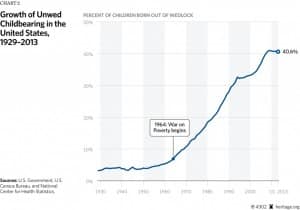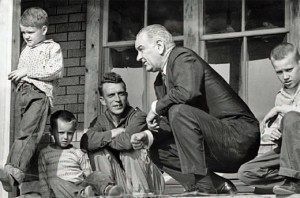In 2 Charts: Why the ‘War on Poverty’ Should Be Renamed the ‘War on Marriage’
Kelsey Harris / @KelsRenHar / December 03, 2014
“First comes love, then comes marriage, then comes a baby in a baby carriage.” Sort of.
I grew up singing the “K-I-S-S-I-N-G” jingle with my elementary school friends during recess. Now many of those same friends have the baby in the baby carriage and a boyfriend. They aren’t alone.
>>>REPORT: How Welfare Undermines Marriage
According to research by Robert Rector, an expert in welfare at the Heritage Foundation, more than 40 percent of all children born in the U.S. were born outside of marriage in 2013, and the number of single-parent families with children has skyrocketed by nearly 10 million.
Rector explains how the War on Poverty undermined marriage:
It is no accident that the collapse of marriage in America largely began with the War on Poverty and the proliferation of means-tested welfare programs that it fostered. When the War on Poverty began, only a single welfare program—Aid to Families with Dependent Children (AFDC)—assisted single parents. Today, dozens of programs provide benefits to families with children, including the Earned Income Tax Credit (EITC), Temporary Assistance for Needy Families (TANF), the Women, Infants and Children (WIC) food program, Supplemental Security Income (SSI), food stamps, child nutrition programs, public housing and Section 8 housing, and Medicaid. Although married couples with children can also receive aid through these programs, the overwhelming majority of assistance to families with children goes to single-parent households.
These charts breakdown exactly how much marriage and childbearing has changed since 1964.




